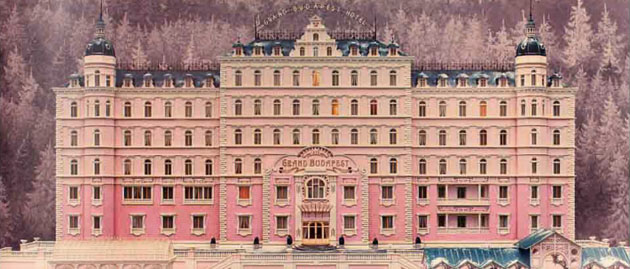Adam Stockhausen

In scouting we had seen a building that had taken what I’m sure was a beautiful ceiling and put a bank of fluorescents over it. Not just a couple fluorescents, a sea of egg crate. We saw this detail and wanted to pull it in. So for our sixties lobby the hotel has this beautiful, five-story atrium and at the first level we just banked it with fluorescents. So there’s this fluorescent egg-crate that’s ten meters by twenty-five meters across. So it gave a very different lighting style to the sixties hotel from the thirties hotel.
AS: How did you end up transforming a department store into the hotel lobby?
AS: Wes had done some very early scouting when he was finishing the script and going around the area of Central Europe where this takes place. He was looking for a needle in a haystack. What you can find a lot of is beautiful old hotels that are still working. But you can’t shoot a movie like our movie there because you can’t shut down a major hotel. So you can find those but you can’t use them. And you can find a lot of really derelict places where the ceilings have fallen in, bats are flying around and the paint is all peeling off the plaster. Those are great but it would cost a fortune and take forever to rehabilitate them. It would almost be easier to build the thing from scratch. So the needle in the haystack was this beautiful, Art Nouveau department store in Görlitz, Germany. The shell of what we made it into was there and in perfect condition. The doors had just been shut.
AS: It was just sitting there empty?
AS: There was one little perfume shop in one tiny little corner of the front but the rest of it was just standing empty. It was unbelievable. And so that motivated Wes to take the entire film to Görlitz. We based out of there and ran the whole operation from Görlitz. We went to a couple of little locations nearby but essentially the whole film was done there.
AS: How many months were you in Görlitz?
AS: I moved out to Görlitz in mid November and I was there until we finished in late March. A cold, snowy run!
AS: Did you build sets there as well?
AS: We did a lot of location building where we take a location and modify it significantly. And then we had some standing sets as well. After we shot the dining room we cleared away the tables and that became our sound stage and we built all the train interiors there and several other sets.
AS: How involved is Wes Anderson in the design?
AS: It’s a total collaboration. He’s a total partner in every aspect and every detail. We talk through every piece. It’s not just, Let me know when it’s done. We’re talking though step by step by step the whole way.
This was one of my favorite films last year with some of my favorite actors. I love being able to read about how it all came to life through the production designer and thank you very much for creating a site where aspiring Production Design/Art Directors, such as myself, can come and learn from the best. Thank you!